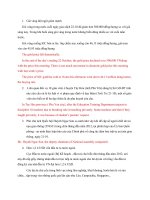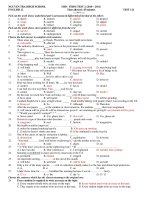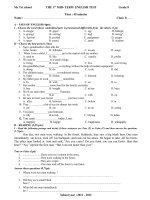MID TERM TEST ON BASICS OF TRANSLATION
Bạn đang xem bản rút gọn của tài liệu. Xem và tải ngay bản đầy đủ của tài liệu tại đây (76 KB, 4 trang )
HANOI OPEN UNIVERSITY
MID -TERM TEST ON BASICS OF TRANSLATION
FOR STUDENTS OF ENGLISH (No 1)
Subject Code: EN42
Full name: Phạm Quang Đoàn
Date of birth: 06/03/1993
Group: FHTM513
I. Answer the following questions: (40 points)
1. What are the different definitions on translation?
Definitions of Translation Part I
Translation is basically a change of form.
Translation is the expression in another language of what has been expressed in one
language.
Translation is the replacement of a representation of a text in one language by a
representation of an equivalent text in a second language.
Translation is rendering a written text into another language in a way that the author
intended the text.
Translating may be defined as the process of transforming signs or representations into
other signs or representations.
Translation may be defined as follows: the replacement of textual material in one
language by equivalent material in another language.
Definitions of Translation Part II
To translate means “to produce a text in a target setting for a target purpose and target
addressees in target circumstances".
Translating consists in reproducing in the receptor language the closest natural equivalent
of the source-language message.
Translation leads from a source-language text to a target-language text which is as close
an equivalent as possible and presupposes an understanding of the content and style of the
original.
Translation can be conceived as an integral communicative performance, which without
any extratextual additions (notes, explanations etc.)
Translating as a code-switching operation.
The ideal translation would be one in which the aim in the target language is equivalence
as regards the conceptual content, linguistic form and communicative function of a
source-language text.
1
2. What is the nature of translation?
THE NATURE OF TRANSLATION
Reproducing the Message
You should bear in mind that translating must aim primarily at “reproducing the message.” To do
anything else is essentially false to one’s task as a translator. But to reproduce the message one
must make a good grammatical and lexical adjustments. A meaningful equivalent is "tender
compassion,” and it is precise in this manner that many translations attempt to reproduce the
significance of this source-language expression.
Equivalence rather than Identity
The translator must strive for equivalence rather than identity. In a sense this is just another way
of emphasizing the reproduction of the message rather than the conservation of the form of the
utterance, but it reinforces the need for radical alteration of a phrase such as I think or in my
opinion which may be quite meaningless.
Dynamic Equivalence over Formal Correspondence
Equivalence in translation is considered mainly in terms of form and meaning. However, over the
past years, translation scholars have focused more on the communicative function than on the
notion of equivalence of the target text. The translator is seen as a bilingual communicator in an
intercultural situation, who can competently produce utterances which are also appropriate in the
given sociocultural circumstances.
A Natural Equivalent
Natural refers to three areas of the communication process: a natural rendering should fit the
whole receptor language and culture, the context of the specific message, and the receptorlanguage audience. Therefore, the translation should bear no obvious trace of a foreign origin. A
natural translation would have to deal with two main areas of adaptation, that is grammar and
lexicon.
II. Translation practice
1. Translate the following text into Vietnamese (30 points)
The two most interesting arguments in The Concept of the Corporation actually
had little to do with the decentralization fad. They were to dominate his work. The first
had to do with “empowering” workers. Drucker believed in treating workers as resources
rather than just as costs. He was a harsh critic of the assembly-line system of production
2
that then dominated the manufacturing sector – partly because assembly lines moved at
the speed of the slowest and partly because they failed to engage the creativity of
individual workers. The second argument had to do with the rise of knowledge workers.
Drucker argued that the world is moving from an “economy of goods” to an economy of
“knowledge” – and from a society dominated by an industrial proletariat to one
dominated by brain workers. He insisted that this had profound implications for both
managers and politicians. Managers had to stop treating workers like cogs in a huge
inhuman machine and start treating them as brain workers. In turn, politicians had to
realise that knowledge, and hence education, was the single most important resource for
any advanced society.
Hai lý lẽ thú vị nhất trong Khái niệm về Tập đoàn thực sự không liên quan nhiều đến xu
hướng phân quyền. Chúng đã chi phối công việc của ông ấy. Lý lẽ đầu tiên là phải "trao
quyền" cho người lao động. Drucker tin tưởng vào việc coi người lao động là nguồn lực
thay vì chỉ là chi phí. Ơng là người chỉ trích gay gắt hệ thống dây chuyền sản xuất mà khi
đó chúng đã thống trị lĩnh vực sản xuất - một phần vì các dây chuyền lắp ráp di chuyển
với tốc độ chậm nhất và một phần vì chúng không tận dụng được sự sáng tạo của từng
người lao động. Lý lẽ thứ hai liên quan đến sự gia tăng của những người lao động tri
thức. Drucker lập luận rằng thế giới đang chuyển từ “nền kinh tế hàng hóa” sang nền kinh
tế “tri thức” - và từ một xã hội do giai cấp vô sản công nghiệp thống trị sang một xã hội
do những người lao động trí óc thống trị. Ông nhấn mạnh rằng điều này có ý nghĩa sâu
sắc đối với cả các nhà quản lý và chính trị gia. Các nhà quản lý đã phải ngừng đối xử với
công nhân như những chiếc bánh răng trong một cỗ máy khổng lồ vô nhân đạo và bắt đầu
coi họ như những người lao động trí óc. Đổi lại, các chính trị gia phải nhận ra tầm quan
trọng của kiến thức, và từ đó thấy rằng giáo dục là nguồn lực quan trọng nhất đối với bất
kỳ xã hội tiên tiến nào.
2. Translate the following text into English (30 points)
Lúc này phải coi tất cả hàng hóa đều là thiết yếu trừ hàng cấm, tất cả đều
quan trọng, theo Bộ trưởng Giao thông Vận tải Nguyễn Văn Thể. Ông Nguyễn Văn Thể
nêu ý kiến trên tại cuộc họp trực tuyến cùng Bộ Công Thương, Bộ Nông nghiệp và Phát
triển Nông thôn, UBND các tỉnh, thành về tạo điều kiện thuận lợi cho vận chuyển hàng
hóa, nơng sản, chiều 25/8. Lãnh đạo ngành giao thông nêu rõ, tất cả các tuyến đường bộ,
3
đường thủy đều là luồng xanh phục vụ vận chuyển hàng hóa."Các phương tiện vận
chuyển hàng hóa đều được lưu thông; cấp mã QR code là để tạo ưu tiên khi qua chốt, chỉ
tiền kiểm, hậu kiểm và xử lý nghiêm minh với các vi phạm", ơng nói và đề nghị các chốt
khi kiểm sốt phải đảm bảo khơng xảy ra ùn tắc giao thông kéo dài, nghiêm trọng; nếu
xảy ra ùn tắc phải xả chốt ngay.
According to Transport Minister Nguyen Van The, all goods now must be considered as
essential except prohibited goods, all are important. Mr. Nguyen Van The expressed the
above opinion at an online meeting with the Ministry of Industry and Trade, the Ministry
of Agriculture and Rural Development, the People's Committees of provinces and cities
on creating favorable conditions for the transport of goods and agricultural products, on
the afternoon of August 25th. Leaders of the transport sector stated that all roads and
waterways are green channels for transporting goods." Vehicles transporting goods are
allowed to circulate; issuing QR codes is to create priority when passing the checkpoint,
only pre-check, post-check and strictly handle violations", he said and suggested that the
checkpoints when controlling must ensure that there are no prolonged and serious traffic
jams; if there is a traffic jam, the gate must be released immediately.
4






